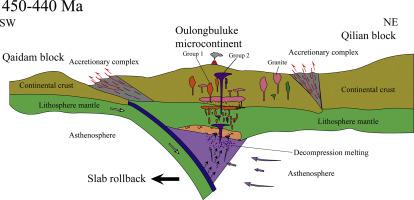当前位置:
X-MOL 学术
›
Gondwana Res.
›
论文详情
Our official English website, www.x-mol.net, welcomes your feedback! (Note: you will need to create a separate account there.)
Early Paleozoic tectonic transition from oceanic to continental subduction in the North Qaidam tectonic belt: Constraints from geochronology and geochemistry of syncollisional magmatic rocks
Gondwana Research ( IF 6.1 ) Pub Date : 2021-03-01 , DOI: 10.1016/j.gr.2020.10.018 Manlan Niu , Qianru Cai , Xiucai Li , Chris Yakymchuk , Qi Wu , Xiaoyu Yuan , Yi Sun
Gondwana Research ( IF 6.1 ) Pub Date : 2021-03-01 , DOI: 10.1016/j.gr.2020.10.018 Manlan Niu , Qianru Cai , Xiucai Li , Chris Yakymchuk , Qi Wu , Xiaoyu Yuan , Yi Sun

|
Abstract The North Qaidam tectonic belt (NQTB) records the tectonic evolution of the South Qilian Ocean from subduction to closure followed by continental subduction. However, the timing of closure of the South Qilian Ocean and the nature of the tectonic transition from oceanic to continental subduction are poorly constrained. In this contribution, an integrated study of petrology, geochemistry, geochronology and Sr–Nd–Hf isotopes is performed on two groups of intermediate–mafic rocks from the Chahanhe intrusive complex in the NQTB. Group 1 intermediate–mafic rocks (441–428 Ma) have arc-like geochemical compositions, high (87Sr/86Sr)i ratios (0.711171 to 0.713181), negative eNd(t) values (−7.22 to −5.49) and low zircon eHf(t) values (−6.3 to +0.5), suggesting that they are derived from partial melting of enriched subcontinental lithospheric mantle. The enriched lithospheric mantle was produced by interaction of the subcontinental mantle wedge peridotite with subducting slab-derived melt and fluid during previous subduction of the South Qilian Ocean. Group 2 mafic rocks (441–439 Ma) exhibit E-MORB-like geochemical compositions with positive eNd(t) values (+2.44 to +3.31) and high zircon eHf(t) values (+1.3 to +6.9), but with high (87Sr/86Sr)i ratios (0.706775 to 0.708661); these features indicate derivation from partial melting of asthenospheric mantle with the involvement of aqueous fluid and minor melt that were probably derived from subducted oceanic crust. We propose that rollback of subducted South Qilian oceanic slab during the initial stage of continental subduction triggered decompression melting of asthenospheric mantle to produce E-MORB-like mafic rocks; convecting and upwelling asthenosphere also provided heat that induced partial melting of the pre-existing enriched lithospheric mantle and generated mafic magmas with arc-like geochemical signatures. Our results improve the understanding of the tectonic transition process from oceanic subduction to continental subduction in the NQTB, the closure of the Proto-Tethyan Ocean, and provide new insights into the importance of crustal growth during initial continental collision.
中文翻译:

柴北缘构造带早古生代大洋向大陆俯冲过渡:来自同碰撞岩浆岩年代学和地球化学的制约
摘要 柴北缘构造带(NQTB)记录了南祁连洋从俯冲到闭合再到大陆俯冲的构造演化过程。然而,南祁连洋闭合的时间和从大洋向大陆俯冲的构造转变的性质缺乏约束。在这项贡献中,对 NQTB 中察汗河侵入杂岩的两组中基性岩石进行了岩石学、地球化学、地质年代学和 Sr-Nd-Hf 同位素的综合研究。第 1 组中基性岩 (441-428 Ma) 具有弧状地球化学成分、高 (87Sr/86Sr)i 比率(0.711171 至 0.713181)、负 eNd(t) 值(-7.22 至 -5.49)和低锆石 eHf (t) 值(-6.3 至 +0.5),表明它们源自富集的次大陆岩石圈地幔的部分熔融。富集的岩石圈地幔是由前次南祁连洋俯冲过程中次大陆地幔楔橄榄岩与俯冲板片衍生的熔体和流体相互作用产生的。第 2 组镁铁质岩石 (441-439 Ma) 表现出类似 E-MORB 的地球化学成分,具有正 eNd(t) 值(+2.44 至 +3.31)和高锆石 eHf(t) 值(+1.3 至 +6.9),但具有高 (87Sr/86Sr)i 比率(0.706775 至 0.708661);这些特征表明软流圈地幔的部分熔融产生了含水流体和可能来自俯冲洋壳的少量熔融物的参与。我们认为,在大陆俯冲初期,俯冲的南祁连洋板块的回滚触发了软流圈地幔的减压熔融,产生了类 E-MORB 基性岩;对流和上涌的软流圈也提供了热量,导致先前存在的富集岩石圈地幔部分熔化,并产生具有弧形地球化学特征的基性岩浆。我们的研究结果提高了对 NQTB 中从海洋俯冲到大陆俯冲的构造转变过程的理解,以及原始特提斯洋的闭合,并为初步大陆碰撞期间地壳生长的重要性提供了新的见解。
更新日期:2021-03-01
中文翻译:

柴北缘构造带早古生代大洋向大陆俯冲过渡:来自同碰撞岩浆岩年代学和地球化学的制约
摘要 柴北缘构造带(NQTB)记录了南祁连洋从俯冲到闭合再到大陆俯冲的构造演化过程。然而,南祁连洋闭合的时间和从大洋向大陆俯冲的构造转变的性质缺乏约束。在这项贡献中,对 NQTB 中察汗河侵入杂岩的两组中基性岩石进行了岩石学、地球化学、地质年代学和 Sr-Nd-Hf 同位素的综合研究。第 1 组中基性岩 (441-428 Ma) 具有弧状地球化学成分、高 (87Sr/86Sr)i 比率(0.711171 至 0.713181)、负 eNd(t) 值(-7.22 至 -5.49)和低锆石 eHf (t) 值(-6.3 至 +0.5),表明它们源自富集的次大陆岩石圈地幔的部分熔融。富集的岩石圈地幔是由前次南祁连洋俯冲过程中次大陆地幔楔橄榄岩与俯冲板片衍生的熔体和流体相互作用产生的。第 2 组镁铁质岩石 (441-439 Ma) 表现出类似 E-MORB 的地球化学成分,具有正 eNd(t) 值(+2.44 至 +3.31)和高锆石 eHf(t) 值(+1.3 至 +6.9),但具有高 (87Sr/86Sr)i 比率(0.706775 至 0.708661);这些特征表明软流圈地幔的部分熔融产生了含水流体和可能来自俯冲洋壳的少量熔融物的参与。我们认为,在大陆俯冲初期,俯冲的南祁连洋板块的回滚触发了软流圈地幔的减压熔融,产生了类 E-MORB 基性岩;对流和上涌的软流圈也提供了热量,导致先前存在的富集岩石圈地幔部分熔化,并产生具有弧形地球化学特征的基性岩浆。我们的研究结果提高了对 NQTB 中从海洋俯冲到大陆俯冲的构造转变过程的理解,以及原始特提斯洋的闭合,并为初步大陆碰撞期间地壳生长的重要性提供了新的见解。



























 京公网安备 11010802027423号
京公网安备 11010802027423号